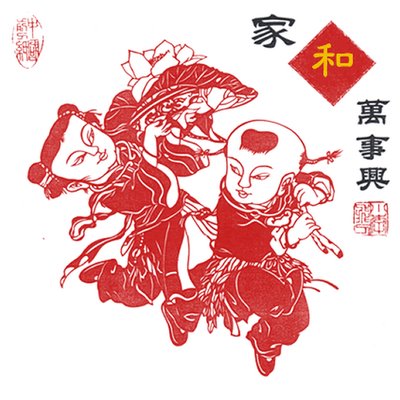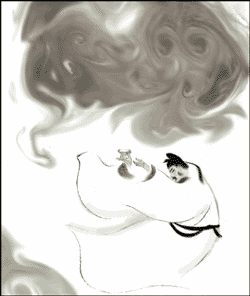 福 禄 寿 禧
福 禄 寿 禧
Prosperity, Wealth,
Longevity and Happiness
Chinese characters usually have one or more meanings and some of them are particularly loved by Chinese people. Fu, Lu and Shou are on the top ten list of the lucky ones.
 福, 'Fu' (Good Fortune) is the Star God of Fortune and Wealth. He sometimes stands one head taller than the other two Star Gods. He is always placed in the centre of them. The Star God of Happiness and Wealth holds a symbol of gold signifying wealth. Fu is one of the most popular Chinese characters used in Chinese New Year.
福, 'Fu' (Good Fortune) is the Star God of Fortune and Wealth. He sometimes stands one head taller than the other two Star Gods. He is always placed in the centre of them. The Star God of Happiness and Wealth holds a symbol of gold signifying wealth. Fu is one of the most popular Chinese characters used in Chinese New Year.
 禄, 'Lu' - Prosperity. It used to mean official's salary in feudal China. Lu is also the God of high rank and affluence. He sometimes holds a small child symbolising wishes of healthy offspring, good fortune and hope of the future and the present. He is also seen at times holding a sceptre of power and affluence. Lu symbolises the opportunity to better ones self and receive high rewards.
禄, 'Lu' - Prosperity. It used to mean official's salary in feudal China. Lu is also the God of high rank and affluence. He sometimes holds a small child symbolising wishes of healthy offspring, good fortune and hope of the future and the present. He is also seen at times holding a sceptre of power and affluence. Lu symbolises the opportunity to better ones self and receive high rewards.
 The Star God of Health and Longevity is called 'Shou', 寿. He is recognised by his large head and he carries a peach in one hand which only blossoms once every three thousand years symbolising immortality. It is considered lucky to wed in the month that the Peach tree blossoms, signifying a long marriage. Shou also means life, age or birthday.
The Star God of Health and Longevity is called 'Shou', 寿. He is recognised by his large head and he carries a peach in one hand which only blossoms once every three thousand years symbolising immortality. It is considered lucky to wed in the month that the Peach tree blossoms, signifying a long marriage. Shou also means life, age or birthday.

The combination of these Three Star Gods are considered auspicious by Chinese people from around the world. The three Gods should be placed in an area which is higher than a table as a mark of their honour. They are said to symbolise certain constellations in the heavens and are acknowledged at certain months of the year.
 禧 - 'Happiness', is an addition to the above three. The Star God of Happiness will springle and shower blessings to ensure people will be happy always.
禧 - 'Happiness', is an addition to the above three. The Star God of Happiness will springle and shower blessings to ensure people will be happy always.
"Fortune", "wealth", "longevity" and "happiness" are the 4 most used words for blessings in ancient China.
There are many statues, figures, posters and ornaments made of these four stars and characters and they are extremely popular.
This carving, which I did on four separate pieces of wood, were joined together in a diamond shape. It is now hanging on the wall in my mom's house with red tassels attached to its bottom. May the Star Gods of Fortune, Prosperity, Longevity and Happiness always be close to her and give her plenty of blessings.

























 This is the first and only carving which is of a 'pop-up' character. For all the other carvings, the characters were carved into the wood but in this one, the background was carved into the wood, leaving the character elevated!
This is the first and only carving which is of a 'pop-up' character. For all the other carvings, the characters were carved into the wood but in this one, the background was carved into the wood, leaving the character elevated!


 In our life, we tolerate. Sometimes we even tolerate the intolerable.
In our life, we tolerate. Sometimes we even tolerate the intolerable. In other situations, we have to tolerate or 'resist' temptations. We must resist unhealthy habbits, criminal acts and even the temptation of delicious desserts if we are dieting.
In other situations, we have to tolerate or 'resist' temptations. We must resist unhealthy habbits, criminal acts and even the temptation of delicious desserts if we are dieting.

 This sentimental poem was written when the poet, Soo, was trapped at a place far away from his home during war time. He wrote this poem in the mid autumn(when the moon was the fullest) to express he thoughts for his brother. These two verses became a popular phrase used to describe the thoughts between separated parties or couples.
This sentimental poem was written when the poet, Soo, was trapped at a place far away from his home during war time. He wrote this poem in the mid autumn(when the moon was the fullest) to express he thoughts for his brother. These two verses became a popular phrase used to describe the thoughts between separated parties or couples. The 'ingredients' for this piece of artwork were quite interesting. It was made by joining two chopping boards I bought from the Value$1 store. These two chopping boards resemble the upper bodies of two people. I had my friend, Brian, cut a part out of one of the pieces and then joined them back but having one raised a little bit. So it looks like one is leaning on the chest of the other.
The 'ingredients' for this piece of artwork were quite interesting. It was made by joining two chopping boards I bought from the Value$1 store. These two chopping boards resemble the upper bodies of two people. I had my friend, Brian, cut a part out of one of the pieces and then joined them back but having one raised a little bit. So it looks like one is leaning on the chest of the other.









 This piece of artwork is my boyfriend's favourite. The idea of having the carving framed up with the depth allowing some love seeds to be displayed makes it so special. There used to be a big old 'love tree' near the main entrance of the my school when I was young. Some of the love seeds I picked during then are still with me! However, many of those have turned into dark red due to age, almost like burnt seeds. The ones in this frame were from Botanic Garden when I visited there two years ago. I put nine of them because 'nine'(九) to chinese, sounds the same as 久, which means for a l - - o - - n - - g time!
This piece of artwork is my boyfriend's favourite. The idea of having the carving framed up with the depth allowing some love seeds to be displayed makes it so special. There used to be a big old 'love tree' near the main entrance of the my school when I was young. Some of the love seeds I picked during then are still with me! However, many of those have turned into dark red due to age, almost like burnt seeds. The ones in this frame were from Botanic Garden when I visited there two years ago. I put nine of them because 'nine'(九) to chinese, sounds the same as 久, which means for a l - - o - - n - - g time! The wood came from a piece of discarded junk wood. Boy, it really took me a while to study its grain to decide which part of it I wanted to use. Watch the photo closely and you will find that the first two characters, which means 'these thing', are on the grain that is pointing to the seeds! Cool huh.
The wood came from a piece of discarded junk wood. Boy, it really took me a while to study its grain to decide which part of it I wanted to use. Watch the photo closely and you will find that the first two characters, which means 'these thing', are on the grain that is pointing to the seeds! Cool huh.